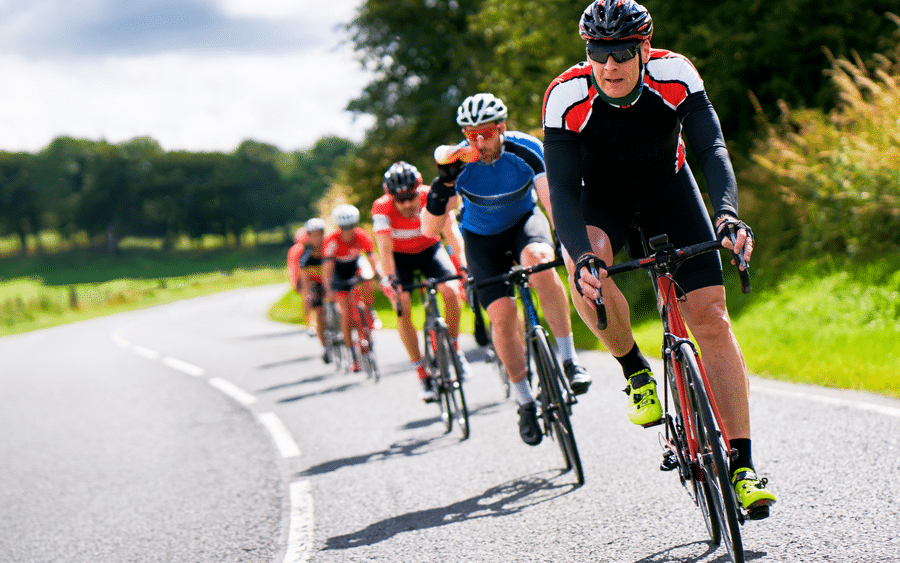Fitness and Performance
How to prevent common cycling injuries

So, you’ve caught the cycling bug? You’re not alone! Government stats report that UK cycling has increased by 200% on weekends and 100% on weekdays since the first Covid-19 lockdown in March 2020. It’s an accessible, sociable sport with so much to offer – it’s good for your mind, cardiovascular health, and muscular strength. Plus, it’s a fantastic way to explore more of what the U.K has to offer!
The catch? Like many other endurance sports, cycling requires you to remain in the same position, repeating the same movements for prolonged periods of time. Without a considered plan for cross-training, cycling injuries like neck and hip pain are common. That’s why we asked Bodyset James Lee to share his top tips on how to prevent common cycling injuries…
“Effective cross training and good preparation are key to reducing your risk of cycling injuries. The right preparation can also help to enhance your performance. While it’s great to get out on the road and make the most of the good weather, make sure you strengthen other parts of your body too.” Says, James.
Neck pain
Cycling injury symptoms: A pain or ache in your neck which can often reach the middle of your back. Rotating your head can be difficult, making it feel stuck or blocked.
Cause: Hunched over your bike for hours at a time can put stress on your trapezius muscles that run along the side of your neck and shoulders. When these muscles are tensed for a long period of time, blood flow to the area is decreased, which starves the muscles of oxygen. This can lead to trigger points, muscle spasms and pain.
Prevention: Most commonly, cyclists need to strengthen the muscles in their neck and shoulders to support the weight of their head for extended periods of time in order to avoid neck related cycling injuries.
- Neck sit-ups
Lie down on your stomach on a flat and raised surface. Let your head hang off the edge in a flexed position. Raise the head past the neutral spine position and up into extension. Complete this movement slowly and controlled, taking about five seconds to lift the head into extension. Complete 3 sets of 10 repetitions if you feel strong enough, or work up to this.
- Weighted shoulder rolls
Bring your shoulders up towards your ears. Keeping your arms down by your side, roll your shoulders back and down. Complete 3 sets of 10 repetitions. You can also make this exercise more difficult by holding weights in each hand.
Gentle neck stretches that loosen your neck and get it moving more freely can help to relieve pain or discomfort too.
Hip pain
Cycling injury symptoms: Hip pain in cyclists can be due to a number of reasons including bursitis, snapping hip syndrome, impingement syndrome, labral tears or piriformis syndrome. Bursitis is one of the most common cycling injuries, identified by pain around the hip and groin or buttock area. Pain may get worse with prolonged cycling or even walking.
Cause: Hip and back pain affects up to 60% of cyclists at some point. Hip pain is often caused by remaining seated in the same posture with decreased flexibility in the hips and muscle imbalances along the legs. Reduced flexibility and an increase in training can irritate and inflame the fluid filled sacs (bursa) at the front of the hip that sit between the muscle and bone to reduce friction.
Prevention: Like many cycling injuries, adjusting your bike saddle and handlebars can do wonders to relieve stress and pain from your body. Raise your seat or handlebars to sit a little more upright and reduce the amount of hip flexion. Having your bike setup checked and improved via a BikeFit assessment could significantly reduce your risk of cycling injury as well as improve your speed and overall cycling performance.
In particular, strengthening weak muscles and loosening tight muscles can help to reduce inflammation of the bursa. Preventative exercises can include hip adduction and abduction, plank, squats, and lateral walking with a resistance band.
- Straight-leg raises
Lie on your side with your legs straight. Lift your top leg until your foot is about 12 inches off the floor, keeping your hip and leg in line with the rest of your body. Hold your leg in the raised position for 6 seconds and slowly lower your leg. Complete 3 sets of 10 repetitions on each leg. You can also work up to performing this with a resistance band to increase strength.
- Side-leaning iliotibial band stretch
Stand next to a wall, placing one hand on the wall for support. Cross the outer leg over the leg next to the wall. Keep the other foot flat on the floor and lean your hips against the wall. Hold for 15 to 30 seconds and repeat three times on each leg.
Knee pain
Knee pain is one of the most common cycling injuries but more often than not, it’s an indication of a problem elsewhere in the body.
a) Patella-Femoral Syndrome
Cycling injury symptoms: Pain or aching around the kneecap which can often feel stiff when getting up from a seated position.
Causes: An imbalance of muscles on the thigh or at the hip can sometimes lead to a change in balance of tension across the kneecap. It can also be triggered by an increase in training intensity and mileage.
Prevention: Try to monitor how much you increase your training over time – increasing your mileage by no more than 10% a week. Muscles and tendons take time to adapt to loading. If the demand is too great and there is not enough time in between training session for your body to recover, then cycling injuries start to occur.
- Straight-leg raises
Lie on your back with one leg bent at the knee, foot flat on the floor, keeping the other leg straight. Tighten the thigh muscles and raise the straight leg about a foot off the ground. Hold for a few seconds, then slowly lower the leg to the ground. Complete 3 sets of 10 repetitions.
b) ITB Syndrome
Cycling injury symptoms: Pain around the outside of the kneecap, often accompanied with a feeling of tightness in the hip on the same side.
Causes: The Ilio-tibial band is a length of fibrous tissue which runs from the hip to the outside of the knee. Repeated movement, weak glute muscles or decreased flexibility in the hip external rotators can cause a muscle balance in the upper leg and create tension on the outside of the kneecap.
- Single leg bridges
For building glue strength, lay on your back with your hands by your sides, your knees bent and feet flat on the floor. Making sure your feet are under your knees, tighten your abdominal and glute muscles. Ensuring that you don’t arch your back, lift your hips up to create a straight line from your knees to shoulders. Squeeze your core and slowly raise one straight leg while keeping your pelvis raised and level. Hold and return to the starting position with knees bent. Complete 3 sets of 12 on each leg.
c) Patella Tendonitis
Cycling injury symptoms: Tenderness and pain underneath the kneecap, on the front of the lower leg. Particularly sore after riding and often painful during the first few minutes of cycling.
Causes: Patellar tendonitis is the inflammation of the tendon that connects the kneecap (patella) to the shinbone (tibia) when placed under too much demand, such as over training or ill-fitting bike set up.
- Terminal knee extension
Tie the ends of a resistance band together to form a loop. Attach one end of the loop to a secure object and loop the other end of the exercise band around your knee. Keep that knee bent. Step the other leg behind you then slowly straighten your bent leg by tightening the thigh muscles. Hold for about 6 seconds before returning to your start position. Complete 3 sets of 10 on each leg.
AC Joint Sprain
Cycling injury symptoms: Pain on the top of the shoulder around the tip. There could also be a raised area above the joint where the capsule has been damaged.
Causes: Falling onto an outstretched hand from your bike can send the force through your arm into your shoulder, where the joint can be strained.
Prevention: This is can often result in a high impact injury that could require scans to assess the level of damage. Consult a physiotherapist of healthcare professional for diagnosis and treatment.
Like many sporting injuries, a wide variety of factors can contribute to the cause of cycling injuries. It’s important to note that the above guide is just a small sample of preventative actions you can take to reduce your risk of common cycling injuries. If you’re in pain or alternatively looking for help on how to improve your cycling performance, please do get in touch and one of our expert physiotherapists will be on hand to create you a bespoke recovery and performance plan.
